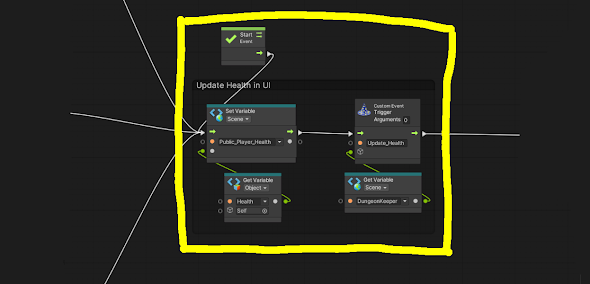I think this is the last piece of the code for the tank, all taking damage, gaining health, and dying. Let's get to it.
The tank has two main colliders, one regular physical collider with a rigid body, and then one slightly larger set as a trigger zone. Things that can hurt the tank like bullets, explosions, enemy shells, all have their own assigned tags. When they cross into the tanks trigger zone, that first bit of script in front of the "If" function is checking the tag to trigger the according health loss. One thing I always forget, and it takes a very long time to debug if you're sleep deprived, the Collider from the On Trigger block needs to be hooked up to the Compare Tag block with that elusive green line.
After the compare/if bit, you can see the Get Variable block pull the tanks current health, subtract the Enemy_Bullet_Damage, and then it feeds that up to a set variable block to update the tanks health.
The next bit is updating the players health in the UI. This bit is also called On Start (top block) so that the UI shows the players health as full. When the player takes damage, this bit updates the Public_Player_Health and then sends a message (Custom Event) to the scene controller (Dungeon Keeper) telling it to set the UI health to be the same as the Public_Player_Health.
This next block I call "popping" the UI, which I go over more thoroughly here. Basically changing the color and size of the UI element just for a moment so the player actually notices something has updated.
This last bit, since Top Down Tank is but a simple game, checks if the players health is less than or equal to zero, and then sends the player to a scene that just says "You Died" if the math checks out. So, now that we have covered losing health and death, I'll show you the whole script and then we'll move to gaining health.
Crash course, the crate in the ruins in the cover image is a health pick up. It has a trigger with a check looking for collision with the player character. When it gets that hit, it sends a message to the dungeon keeper and the player to update their health records, and here's how it goes.
The first block is a Custom Event waiting to receive the message "Health40" from a crushed crate. Now comes the tricky part. We don't want the player to raise their health past the tanks maximum, so we first have a check to see if the players health is at least (Less or Equal) 40 points less than full. This game (unfortunately for me) let's the player select from a number of different tanks with different levels of health, all of which are stored in a list called T6_UpgradeList (Get Variable) from which we are pulling the first slot (List - Get Item - 0) because this tank is not upgrades. If they had two health upgrades, we'd be pulling from Index: 1.
Once we have the health, we subtract the potential health boost (40) and then check if the player has taken at least 40 points of damage. If yes, we just go ahead and add (Set Variable - Add) the 40 points back to the players health.
If the players health is less than 40 points from being full, we just go back to the upgrade/health list, pull the maximum recorded health, and set the player back to full. This sounds annoying and fiddly, but it's very easy to slip up and allow the players health to grow forever line they're the blob.

Anyway, thanks for reading. Maybe next I'll go more in-depth about how pick ups work. If this is helping, maybe throw me something on Ko-Fi, or buy a Kaiju game. I'll probably keep making these either way.
Stay fresh, cheese bags.











































